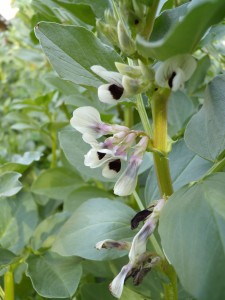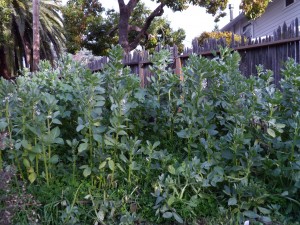A few weekends ago, while volunteering at a local school garden, I overheard someone complain that favas are ugly beans. While she conceded that they make a good foolproof crop for kids to grow, she said she never plants them herself.
I was surprised and vaguely wounded on behalf of favas, but I took a deep breath and stepped up to their defense. Personally, I find fava beans quite visually stunning, with their erect stature and silvery foliage. I am particularly partial to the sight of a stand of Favas in early morning light with a good dose of dew.
But beyond their visual merits, favas have a venerable history as world travelers, and a lot to offer in the garden.
Cover cropping
Like all members of the legume family, favas fix nitrogen in the soil. This makes them invaluable as a cover crop, planted to rejuvenate the soil’s nutrients and structure. To take advantage of nitrogen fixation, it’s important to cut the plant before the beans form. According to John Jeavons’ How to Grow More Vegetables, legumes should be cut when they are at 10% to 50% flower.
For green manures, simply cut the favas up and dig them into the soil, allowing several months for decomposition before planting. Another option is to cut the plants at the base, leaving the roots intact, and include the plants in your next batch of compost. I favor this second approach, in large part because it allows me to get my next crop in the ground quickly.
If you allow the beans to mature, the dead plants can be used as a high-carbon addition to your next compost pile.
Eat the beans!
Fava beans are good fresh or dried. They make Jeavons’ list of “significant-calorie-producing” crops. It’s important to note that some people are deathly allergic to this type of bean, suffering from a condition commonly referred to as favism (no joke!). It’s also interesting to note that fava beans shouldn’t be fed to chickens, as this negatively impacts the birds’ metabolism, growth rate, and feed efficiency. That being said, favas are commonly eaten by people in many parts of the world and are protein superheroes in the vegetable kingdom.
Frost tolerance
Favas can hang in there at temperatures of 21 degrees Fahrenheit and lower, depending on the variety. If you plan to eat the beans, the general recommendation is to plant in February or March. For cover cropping, plant in September through November. This year, I got the beans in the ground in October, and they’re coming along nicely.
Bee food?
We won’t claim it’s their favorite food source, but our bees have definitely checked out the fava flowers this winter. Kelly recently reported what she described as a “frustrated looking bee” attempting to navigate into a fava blossom.
According to one source I found, honey bees are unable to access nectar through the front of the flower, and must go around to the back instead. However, a number of studies have found honey bees to be important fava pollinators.




7 Responses to In Praise of Fava Beans